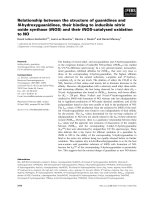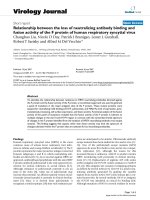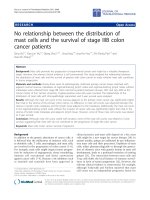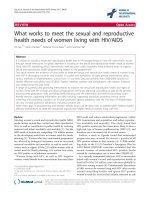Relationship between socio-economic traits of women trainees with their income generation by Krishi vigyan kendra, Chomu (Jaipur) Rajasthan
Bạn đang xem bản rút gọn của tài liệu. Xem và tải ngay bản đầy đủ của tài liệu tại đây (175.26 KB, 4 trang )
Int.J.Curr.Microbiol.App.Sci (2020) 9(3): 304-307
International Journal of Current Microbiology and Applied Sciences
ISSN: 2319-7706 Volume 9 Number 3 (2020)
Journal homepage:
Original Research Article
/>
Relationship between Socio-Economic Traits of Women Trainees with their
Income Generation by Krishi Vigyan Kendra, Chomu (Jaipur) Rajasthan
Rakesh Kumar Kansotia1*, Jagdish Prasad Yadav1, Ajit Kumar Ghoslya1,
Nitesh Kumar Tanwar2 and Naresh Kumar Kumawat3
1
Department of Extension Education, SKNAU, Jobner, India
Department of Extension Education, MPUAT, Udaipur, India
3
Department of Extension Education, SKRAU, Bikaner, India
2
*Corresponding author
ABSTRACT
Keywords
Women,
Income generation,
Vocational
training
Article Info
Accepted:
05 February 2020
Available Online:
10 March 2020
Women are the backbone of a family by getting technical knowledge
through vocational training and may change their whole life. They will
utilize all their mind power by use of new techniques, they also make them
self - depend. The study was conducted in Jaipur district of Rajasthan. A
list of vocational training and trained women was prepared with help of
SMS of KVK Chomu. A sample of 105 women trainees was randomly
selected from all 753 women trainees from different agricultural aspects for
recording their responses towards their empowerment. The age, caste and
type of house were found to have non-significant relationship with income
generation of trained women. The occupation, education level, social
participation, marital status, size of land holdings, mass media
participation, vocational trainings received, economic motivation, market
orientation and risk orientation were found to have significant relationship
with income generation of trained women.
multi-dimensional process which should
enable women or group of women to realize
their full identity and power in all spheres of
life. “Empowerment comes from Women‟s
groups who seek to empower themselves
through greater self- reliance.
Introduction
Income generating activities are considered as
those initiatives that affect the economic
aspects of people‟s lives through the use of
economic tools such as credit. It is being
increasingly realized that women‟s income in
a family is very important in relation to the
nutritional, economic and educational
upliftment of the family. Empowerment is a
They have right to determine their own
choices in life. They also seek to gain control
and access to resources”. Through vocational
304
Int.J.Curr.Microbiol.App.Sci (2020) 9(3): 304-307
trainings various changes occur in women
behaviors like:
dependent and independent variables. The
correlation coefficient between two groups
was calculated by using the following
formula.
Enhanced self-esteem and self-confidence in
women.
Build a positive image of women by
recognizing their contribution to the
society and economy.
Develop in them an ability to think critically.
Foster decision-making action through
collective process.
Enable women to make informed choices in
areas like education, employment and
health.
Ensure equal participation in development
process.
r=
xiyi- (xi) (yi)/N
xi2- (xi)2/N
yi2- (yi)2/
Where,
r
=
N
=
xi
=
pair
yi
=
pair
Materials and Methods
Correlation coefficient
Number of paired observations
Value of x variable for ith
Value of
y variable for ith
The significance of correlation coefficient
was tested by „t‟ value, which was measured
by using following formula:
The study was conducted in the Jaipur district
of Rajasthan. The samples of the study were
selected by two stage sampling method. These
were - (1) Selection of Krishi Vigyan Kendra
(KVK) (2) Selection of respondents. KVK
Chomu was selected purposely because this is
one of the oldest (1992) KVK working under
NGOs (Non-Government Organizations) in
Rajasthan where maximum numbers of
vocational women trainings (753) were
organized for women empowerment and
17853 women were trained in different
professional aspects in the last twenty years
from 1996 to 2016 (Annual report of ATARI,
Jodhpur). A list of all vocational trainings
conducted by KVK Chomu for women
empowerment was prepared with the help of
SMS of KVK Chomu. Total 695 rural women
were trained in different vocational aspects
related to agriculture purpose (fruit and
vegetable preservation, nursery raising and
dairy farming) during last five years (2011-12
to 2015-16) 15 per cent (105) trained women
were selected randomly for the study.
r - N - 2
t =
1 - r2
d.f.
=
N–2
The value of „r‟ always lies between -1 to +1.
The positive value of „r‟ indicates a tendency
of „x‟ and „y‟ to increase together. Where „r‟
is negative, large values of „x‟ are associated
with small values of „y‟. For test of
significance „r‟ tabulated is located at (n-2)
degrees of freedom.
Relationship between socio-economic traits
of women trainees with their Income
generation
The relationship between income generation
of women trainees and the selected
independent variables viz. their age, caste,
occupation, education, social participation,
marital status, land holding, type of house,
mass media participation, vocational training
received, economic motivation, market
orientation and risk orientation were
Correlation coefficient
The correlation coefficient („r‟ value) was
used to measure the relationship between
305
Int.J.Curr.Microbiol.App.Sci (2020) 9(3): 304-307
measured by computing “Coefficient of
correlation (r)”. The data have been presented
in table 1.
participation, marital status, land holding,
vocational training received, economic
motivation,
market
orientation,
risk
orientation was positively and significant
associated at 5% level of significance where
as age, caste and type of house was positively
and non significantly related with the income
of trained women.
The values of coefficient of correlation
furnished in table 1 clearly show that income
of trained employed women was positively
and significantly associated with education
and mass media participation at 1% level of
significance where as occupation, social
Table.1 Relationship of the selected independent variables with the income generation by the
women trainees
N=105
Correlation coefficient (r)
S. No.
Independent variables
Income Generation N= 105
Age
0.2271
1.
Caste
0.3182
2.
Occupation
0.3875*
3.
Education
0.5061**
4.
Social participation
0.3596*
5.
Marital status
0.3369*
6.
Land holding
0.3818*
7.
Type of house
0.2579
8.
Mass media participation
0.4454**
9.
Vocational training received
0.3352*
10.
Economic motivation
0.3442*
11.
Market orientation
0.4077*
12.
Risk orientation
0.3349*
13.
* Correlation is significant at the 0.05 level
** Correlation is significant at the 0.01 level
Hence, the null hypotheses H01.3, H01.4, H01.5,
H01.6, H01.7, H01.9, H01.10, H01.11, H01.12and
H01.13were rejected and alternate hypotheses
were accepted, which shows that the women
trainee's occupation, education, social
participation, marital status, land holding,
mass media participation, vocational training
received, economic motivation, market
orientation, risk orientation were significantly
associated with income of women trainees. It
can, therefore, be generalized that higher
score of occupation, education, social
participation, marital status, land holding,
mass media participation, vocational training
received, economic motivation, market
orientation, risk orientation of the women
trainees then higher would be their income.
It can be concluded that income of women
trainees increases with the income in
occupation. This might be due to the facts that
women‟s occupation as dairy and agriculture
with more land might have got more income.
The educated women might have certainly
learned more, understood more about the
various activities of KVK due to their higher
mental capabilities and use of latest
technology and get maximum income. This
306
Int.J.Curr.Microbiol.App.Sci (2020) 9(3): 304-307
might be due to the fact that the women
trainees had more exposure by virtue of being
member in different rural institutions like
gram panchayat, block panchayat, village
cooperative society, Kishan Mandal etc.
leading to their active participation in social
activities.The marital status was found
significant relationship because married
women have more responsibility about
income generation on their own farms to
increase income of family.The income has
increased with the land holding. It might be
because of more work on the large size of
land holding as they might be taking more
crops. Themass media participation of trained
women‟s increase income in the fruit and
vegetable
preservation
and
increase
knowledge because the knowledge leads more
production increases their income. The
vocational training received was increased
their skill and skilled women get more
income. Economic motivation of trained
women is increased their income because
trained women have knowledge about
economically increased living standard of
family. The market oriented women have
knowledge about the market price of the
product which is produced by them and
increase their family income. The risk
oriented women trainees, It is better for an
entrepreneur women not to try new methods
unless to be proved better by other women.
Further, the trained women‟s age was found
to have a positive and non-significant
relationship with their income. It means that
age did not have a significant effect on the
income generating activities of the women
trainees. It might be due to the reason that old
aged women could not perform heavy work
due to their mild attitude and their physical
weakness. Caste and type of house was found
to have a positive and non-significant
relationship with their income means caste
and type of house could not play any role in
income generation of trained women. The
present findings are in conformity with
Jaiswal (2008) and Ali (2001).
References
Rajput, J. S.; Latoria, S. K.; Kakran, M.S. and
Sharma, P. 2005 “Correlates of training
needs of farm women in Krishi Vigyan
Kendra, (M.P.)”. Madhya J. Ext. Edu.,
8.
Samantha, P.K. 1977 “A study of some agroeconomic, socio psychological and
communication variables associated
with
repayment
behaviour
of
agricultural credit users of nationalized
bank”, Ph.D. Thesis, BCKVV (W.B.)
India.
Singh, A.P.; Singh, A. K. and Kumar, A.
2014 “Association of empowerment
level and socio-economic condition of
women in Harahua block of Varanasi,
(U.P.)”. Current Advances in Agril. Sci.,
6(1).
Sultana, A. and Hossen, S.K. 2013 “Role of
Employment in Women Empowerment:
Evidence from Khulana City of
Bangladesh”. International J. Soc. Sci.
Interdisciplinary
Res.,
2277
3630IJSSIR, 2 (7).
Yogendrarajah, R. 2012 “The impact of micro
credit on women empowerment”.
International J. Res. in Commerce,
Economics and Management, 2(5).
How to cite this article:
Rakesh Kumar Kansotia, Jagdish Prasad Yadav, Ajit Kumar Ghoslya, Nitesh Kumar Tanwar
and Naresh Kumar Kumawat. 2020. Relationship between Socio-Economic Traits of Women
Trainees with their Income Generation by Krishi Vigyan Kendra, Chomu (Jaipur) Rajasthan.
Int.J.Curr.Microbiol.App.Sci. 9(03): 304-307. doi: />
307









